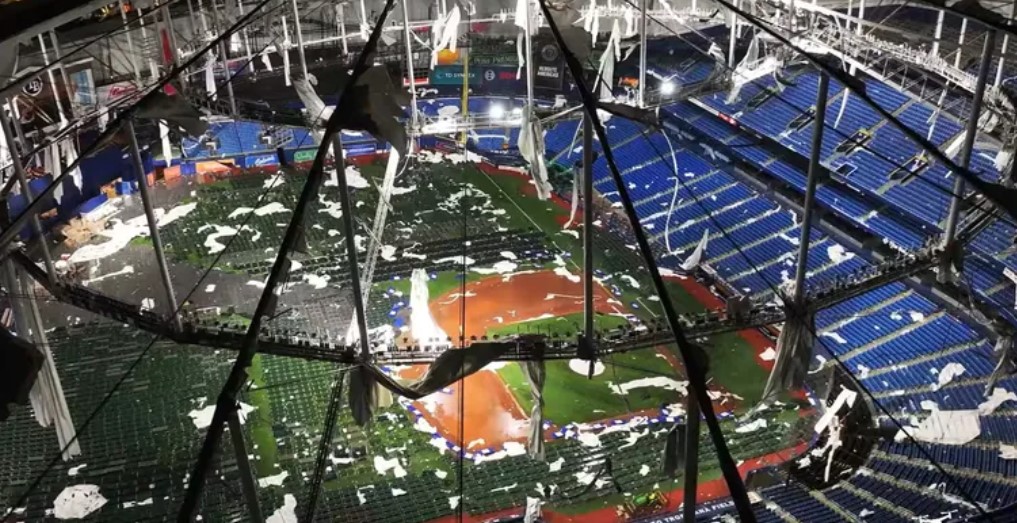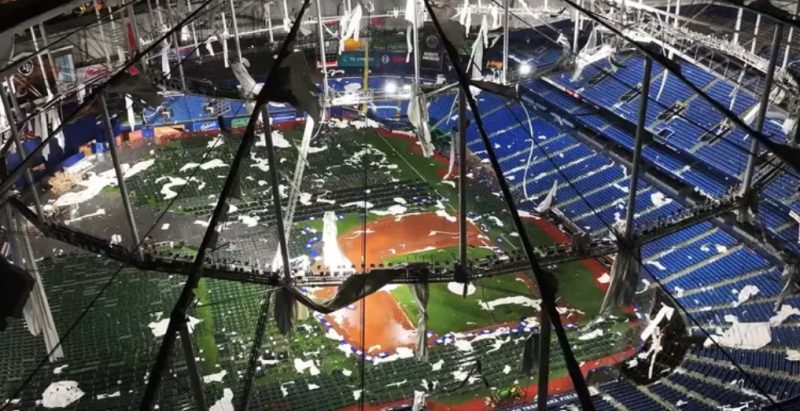
Hurricane Milton made a devastating mark on Florida, tearing across the state with torrential rain, powerful winds, and catastrophic flooding. As the state begins to assess the full scope of the damage, the road to recovery is daunting.
Here’s a detailed look at the aftermath of Hurricane Milton.
Milton’s Path of Destruction: Wind and Water Unleashed
Milton made landfall on Florida’s Gulf Coast near Siesta Key as a Category 3 hurricane on Wednesday evening. With winds exceeding 100 mph, it brought a storm surge that overwhelmed coastal towns. Cities like Sarasota and St. Petersburg faced winds that downed power lines, uprooted trees, and caused extensive property damage.
One of the most affected areas was Madeira Beach, where a house caught fire after a power line was brought down by the fierce winds. Nearby, Sarasota clocked the strongest recorded gusts of 107 mph.
Milton wasn’t just a wind event—it also unleashed relentless rain, with parts of the state recording over 10 inches in a matter of hours. Flash floods surged through major cities like Tampa and Orlando. In Tampa, a flash flood emergency was declared after a torrential downpour left streets submerged, homes flooded, and cars stranded.
Tornadoes Add to the Chaos
In addition to hurricane-force winds, Hurricane Milton spawned a series of deadly tornadoes as it crossed the state. St. Lucie and Martin counties, on Florida’s east coast, were especially hard-hit. Several communities faced tornado damage, with roofs ripped off, homes destroyed, and residents forced to flee to safety. A total of 100 tornadoes were reported as the storm moved across central and eastern Florida.
The combination of tornadoes and hurricane winds left many areas virtually unrecognizable. Martin County officials reported that recovery would take weeks, if not longer, as emergency services worked to clear debris and restore essential services.
Flooding Brings Water Rescues and Widespread Devastation
Flooding was one of Milton’s deadliest weapons. Low-lying areas in Central Florida, including Orlando, saw massive rainfall that quickly led to flash floods. In many neighborhoods, the water reached chest-deep levels, trapping residents in their homes. Orange County fire rescue teams conducted dramatic rescues throughout the night, including saving a family of four from rising waters.
More than 700 water rescues were carried out in Hillsborough County alone. Emergency responders worked through the night to pull people from cars stranded in flooded streets and homes that were quickly becoming waterlogged. Local authorities warned residents to remain vigilant even as the storm passed, as floodwaters could take days to recede.
Power Outages Affect Millions
Hurricane Milton’s fury left more than 3 million Floridians without power. Major outages stretched from Tampa to Orlando and as far south as West Palm Beach. At its peak, the storm knocked out more than 5,000 traffic signals, and power lines across the state were downed by both winds and tornadoes.
Utility companies deployed more than 50,000 linemen to restore power, but the sheer scale of the destruction means it could take days or even weeks to fully restore electricity. The lack of power adds another layer of difficulty for the state’s recovery, as residents struggle without electricity for cooking, medical equipment, and air conditioning during Florida’s sweltering heat.
Major Landmarks Damaged

Among the notable casualties of Hurricane Milton was Tropicana Field, the iconic home of the Tampa Bay Rays. Photos and videos captured portions of the stadium’s roof being torn away by the storm’s strong gusts. Initially slated to be a staging area for first responders, the stadium’s damage forced emergency workers to relocate elsewhere.
Public infrastructure across the state was severely impacted as well. Roads remained impassable due to flooding and debris, and it will take time before normalcy returns to Florida’s transportation networks.
Milton’s Exit: A Trail of Destruction Left Behind
By early Thursday morning, Milton had moved off the coast of Florida and into the Atlantic Ocean, but the damage was done. The state now faces a lengthy recovery from the storm’s wrath. With a combination of water damage, wind destruction, and widespread power outages, recovery teams will be working around the clock to rebuild.
Florida Governor Ron DeSantis emphasized that the state’s response teams are fully mobilized, with the National Guard and utility workers spread across the state. Despite the efforts, the emotional and physical toll on residents is palpable, especially in communities still recovering from previous hurricanes. Milton’s devastation is another harsh reminder of the state’s vulnerability to severe storms and the challenges that come with climate change.
Looking Ahead: Preparing for Future Storms
As Florida grapples with the aftermath of Hurricane Milton, the broader question looms: How can the state better prepare for future hurricanes? With climate change making storms more frequent and more intense, there is an urgent need to rethink infrastructure resilience, emergency response, and coastal development.
Hurricane Milton serves as a stark warning. Florida, a state already prone to hurricanes, may be facing a future where such storms are not rare occurrences but a new normal. The challenge now is not only to rebuild but to build smarter, stronger, and with the reality of a changing climate in mind.
